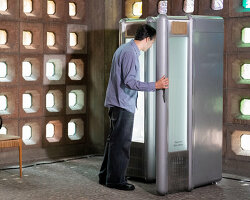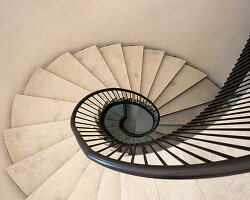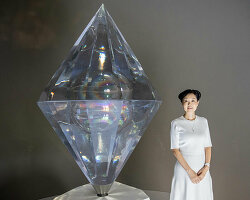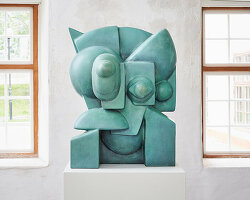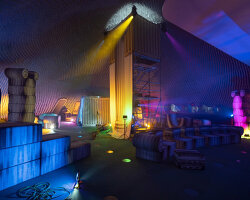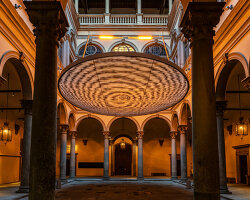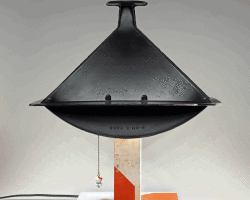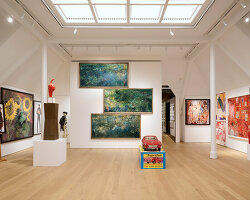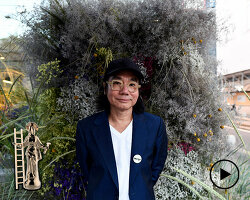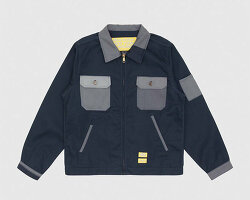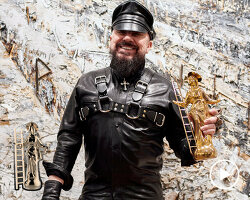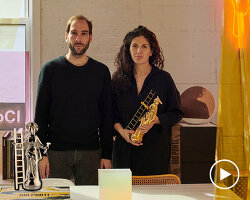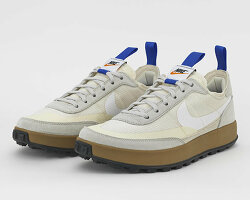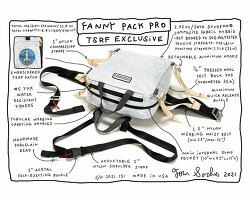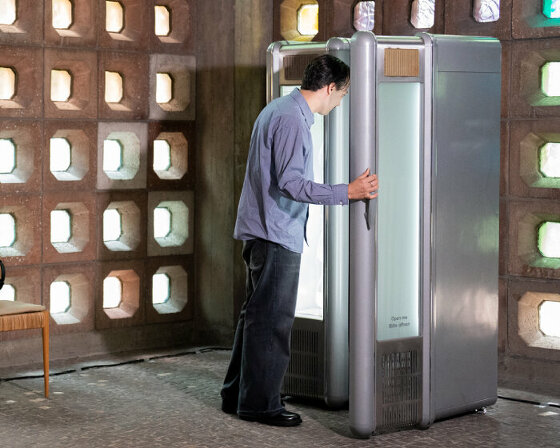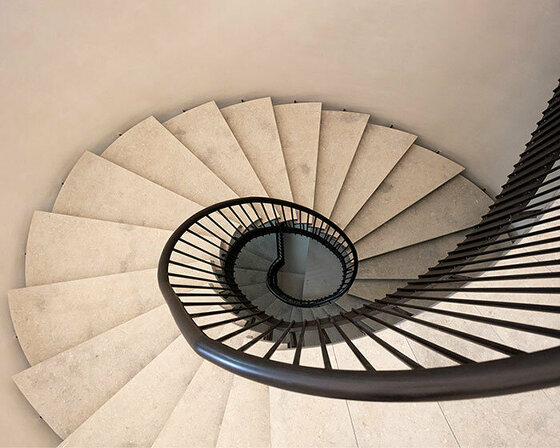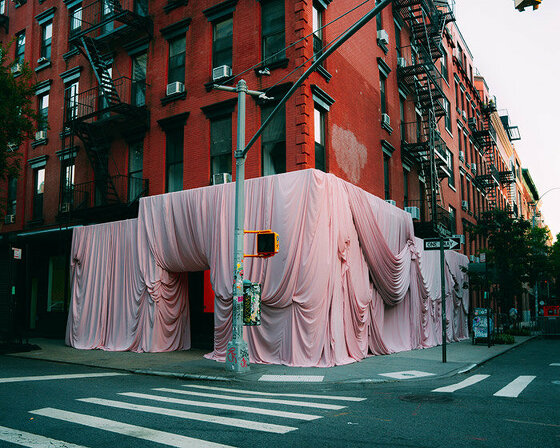designboom spoke with US artist tom sachs, ahead of being awarded with the golden madonnina trophy 2021 of milan’s THE DESIGN PRIZE. born in 1966 in new york, sachs recreates various modern icons with his distinct bricolage aesthetic, which has gained him a unique position in the field of contemporary sculpture. meanwhile, his longtime fascination with space exploration has led him to create an entire body of space-related works, including his immersive space programs, as well as his longstanding creative collaboration with NIKE (see designboom’s extensive coverage here).
during our interview, sachs talks about his creative process, shares advice for the young, and goes deep into his current exhibition, ‘ritual’, at gallery thaddaeus ropac in london (previous coverage of ‘ritual’ here). ‘as I create, I meditate, and the lust of acquiring a product is replaced by the love of making it,’ reads a quote from the exhibition’s description. the new works on view draw from new york city’s corner shops, known also as bodegas, and their reflection of the diverse civic and cultural demands of modern city living. the artist replicates commonplace industrial objects using everyday materials including plywood, cardboard, resin, tape and paint. the sculptures bear traces of their making, becoming vehicles for reflection on the creation of value and human labour.
watch our interview with the artist in full on the video above, or read excerpts from it below.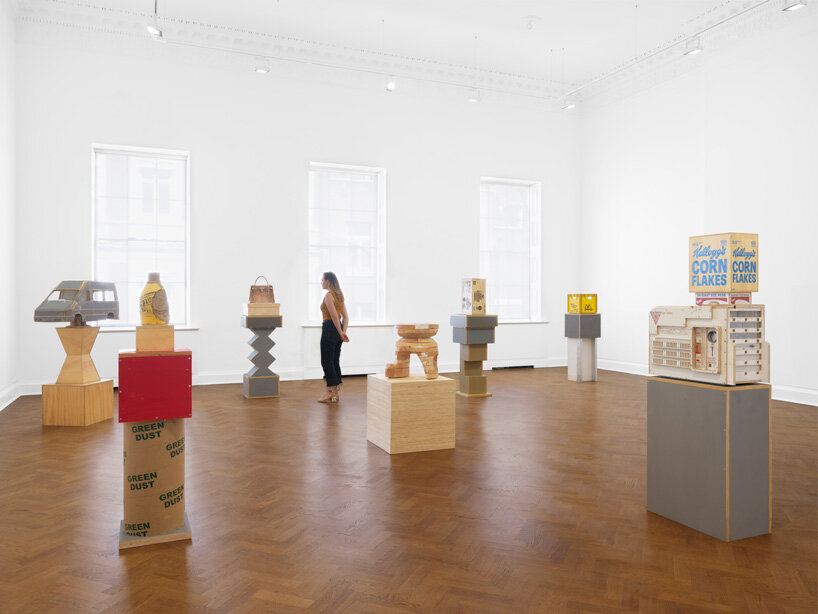 tom sachs: ‘ritual’, on view from june 3 to july 31, 2021
tom sachs: ‘ritual’, on view from june 3 to july 31, 2021
all images © tom sachs, courtesy thaddaeus ropac, london – paris – salzburg
photos by genevieve hanson
designboom (DB): why is the exhibition at at thaddaeus ropac called ‘ritual’?
tom sachs (TS): the exhibition is an extension of the gallery show in paris, and that’s why the title is the same, even though they’re new works. for me, we all have rituals, right? even right now, this is one, because you are journalist, so you interview people, and I talk to you. there are so many rituals, and the main ritual for me is the ritual of work. I love the common things, like getting a cup of coffee and brushing my teeth, but for me, it’s about showing up to the studio everyday for 30 years, rain or shine. but there are so many other rituals, so it’s a broader term. the role of the flaneur, of the person who walks the street, is a ritualistic act; you do it every day, it’s a meditation. the ritual of work and building things – I also got a little zine about it with all the works – is inspired by so many things, but one of the main things is the streets, and my experience in the street as a junk collector, as a scavenger. and I would include photography, as part of the scavenge.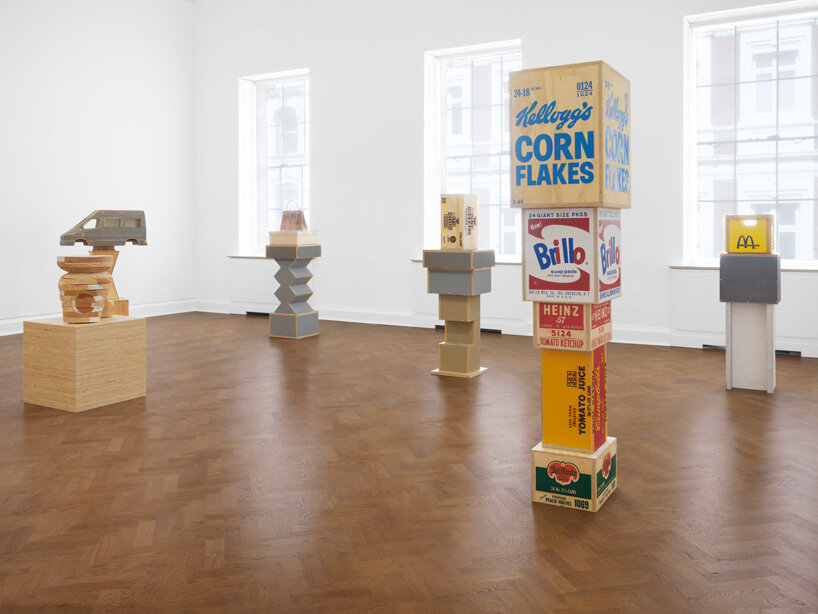
TS (continued): those photographs in the zine are part of a series that I’m working on called, ‘things that are too big, dirty or expensive to fit in my apartment’. things that I want, like, I would love a new york city garbage truck, but the idea of parking such a thing, I just can’t manage the expenses. it would literally be bigger than a white elephant. but they are beautiful objects, right? the noise, what it does, its part in the waste cycling system. one of my dreams is to have one and have the inside carved out to be an office, and just park it wherever the fuck I want. and just have that be my urban office. no one can tow it, because it’s so big, and that also comes as a response to the daily combat that I experience in my moments of insanity when I try and drive in new york city with a regular car. it’s a punishable offence just to drive, every possible thing, from parking tickets to potholes to traffic, you shouldn’t do it. in any city, you don’t need cars, and those of us who have them are rightfully punished severely.
DB: maybe it’s their own ritual though.
TS: absolutely, that’s well said, I didn’t think about that. but absolutely, it’s part of it. it doesn’t have to be a good ritual! so yeah, I think that’s my inspiration, where it all comes from.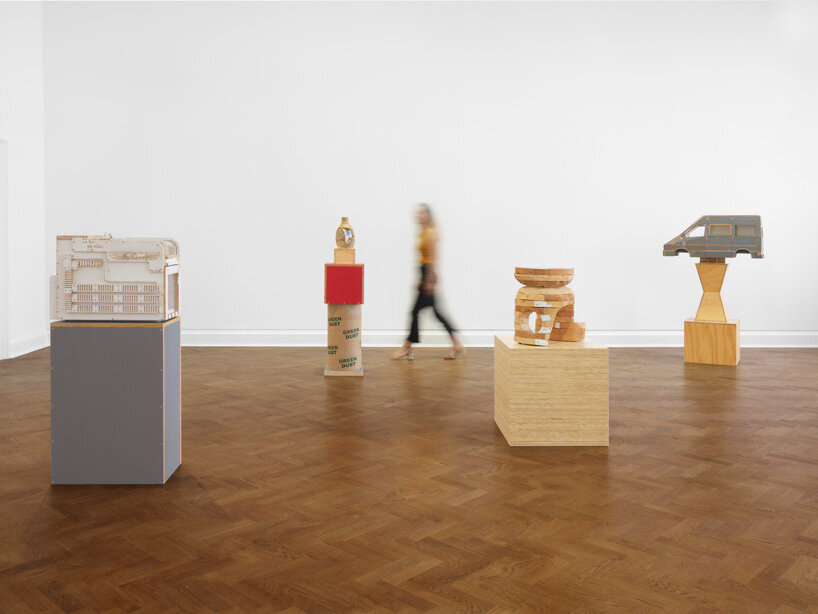
DB: do you follow certain rituals in your daily work, or life in general?
TS: yeah, we just shipped this show, so today is cleanup day. it’s about cleaning, restocking tools, throwing out stuff. when you come to the studio, at first, you might think ‘wow, there’s a lot of shit here’. but, really, every time something comes in something else goes out, I’m not a hoarder. I do have moments of regret, like when something is thrown out, it’s usually the next day that I need it. but in aggregate, you got to be ruthless. I’m a marie kondo devotee, even before I knew about her, I was practicing those things. I love her because she articulated so many ideas that I’ve been following, and is like a master. so I deepened my knowledge of understanding, but I think the main thing is always, and this is her words, ‘if it brings you joy, keep it’. and even if something brings you joy, it’s important to connect with something and then let it go. because you can always get it again, if you really need it. but the worst thing that can happen is keeping shit around that weighs on you and sucks your soul. that’s much much worse.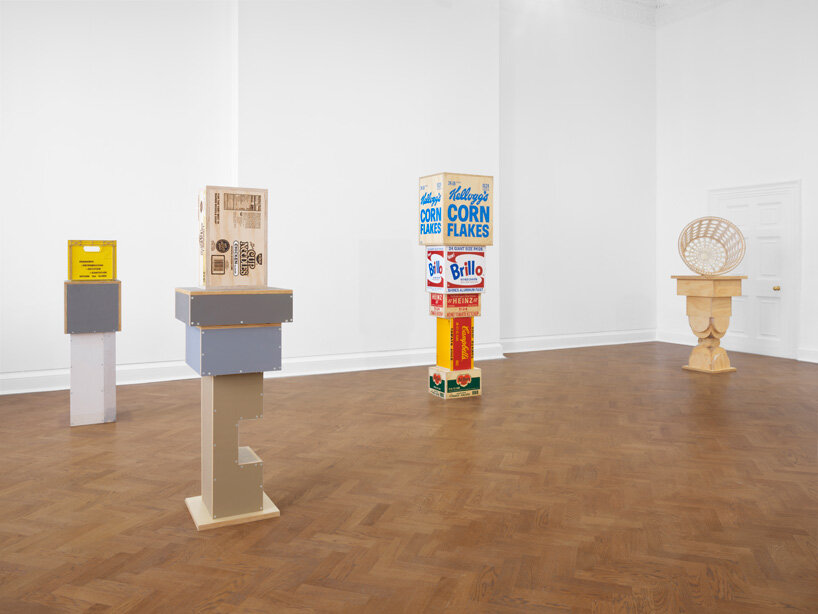
TS (continued): so, cleaning, getting rid of things, and becoming one with my environment is the most important thing. once all of that noise is cleared out, then I can begin to trust my intuition and know what just the right wrong decision to make in my sculpture. because some of the ideas seem capricious, or dumb, but when they are followed through with thousands of hours of serious execution, then the ritual of that work is the thing that brings power and energy and concreteness to the sculpture. like, this van that I always wanted, the old mercedes sprinter van from the 90’s. the new one’s not as nice, the old one is nice and square. so, to think, ‘oh, I’m gonna make a sculpture of a rusty van,’ that seems kind of dumb. but through the love and execution of that, through really obsessing, it gets pretty good. because you see all the detail and all the mistakes that have been fixed over and over again, till it just got right. and that pastiche of materials, and techniques, and marks, and glue drips and stains and screw heads and all that stuff, it’s authentic. it’s not like I set out to make it look all fucked up like that. it was just putting a lot of time and then at some point you stop.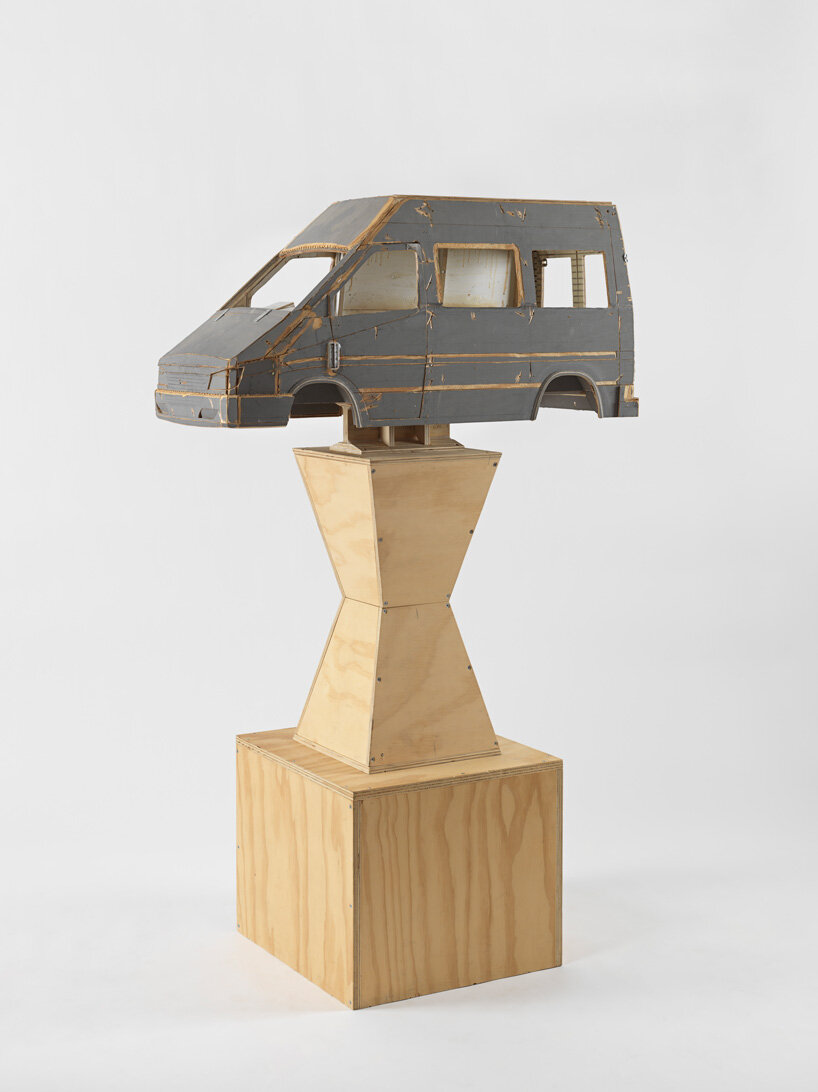 tom sachs, ‘sprinter’, 2020 | plywood and synthetic polymer with steel hardware | overall 149,9 x 91,4 x 48,3 cm (59 x 36 x 19 in) | sculpture 48,3 x 91,4 x 38,1 cm (19 x 36 x 15 in) 40 x 19 x 19 in
tom sachs, ‘sprinter’, 2020 | plywood and synthetic polymer with steel hardware | overall 149,9 x 91,4 x 48,3 cm (59 x 36 x 19 in) | sculpture 48,3 x 91,4 x 38,1 cm (19 x 36 x 15 in) 40 x 19 x 19 in
DB: you often use symbols that are familiar to us, like cars that we’ve seen on the street, as source material in your works, but the outcome is rarely an exact replica. the process behind it feels almost like a ritual; you work on the sculpture again and again, to the finest detail, but still making it different to the initial reference. is it more about the process of reproducing these symbols, and what comes out of that process, rather than having an absolutely identical object as a final result for you? and, when in the process do you know that it’s done, that you’ve got what you wanted and the work is ready?
TS: after making things for 30 years, I know the right way to do it so that it literally looks like the exact thing, and that involves a lot of planning. the skill that I’ve cultivated over all these years is relying on my intuition to be shitty, to let my impulses lead, let, I want to say, this sensual desire. like when you cut wood, it feels emotionally good for us who really make things. there are some materials that I like and some materials that I don’t like. I don’t like noisy materials, like a chalkboard, or fax paper, I don’t like loud machines, just because it makes me shiver. I like things that feel good, and I also like it when the wood is painted and then it’s cut so that you can really see that you were there. this isn’t necessarily the right way of doing things, but I’m trusting my emotional desire, that’s why I use the word ‘sensuality’, like when touching clay. some people like hard pencils and some people like soft ones, you have your one.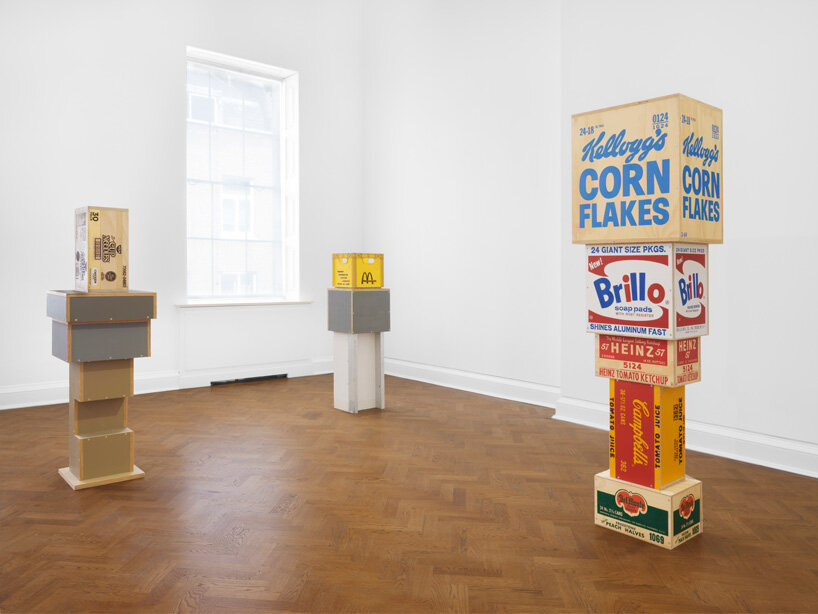
TS (continued): I started by talking about cleaning my studio, I clean my environment and I clean my head and then I can really trust what is going on in my heart and my feelings and then I go at it, sort of without a plan. although I’ve been planning the whole time because while I’m sweeping, I’m thinking – sorry to use this word – but I’m meditating on the van, I’m meditating on the idea of ‘I want to make this van, what do I like about it? well, the old one’s nice and square, the new one’s kind of curvy, and gross, it looks like it was computer-designed, the old one was probably drawn by hand, maybe it was the end of cars being drawn by hand. and now they’re all drawn by computers. and maybe I don’t really understand that, but I can sense it on some level, because it’s a little rougher.’ I don’t know, I’m guessing, I don’t know if that’s true. but I guess the main thing is understanding and trusting and accepting yourself so you can trust to do it the wrong way. and then trust that not only you do it the wrong way, but you’re going to commit whatever thousands of hours to this way of doing, versus having a plan, drawing it out, talking about it, scheduling it, and doing it. at the end it will be perfect but anyone could do that. I’m the only one in the whole world that can trust my own intuition and do it my way. what I’m trying to articulate isn’t just my creative process, I think a lot of artists work this way, I don’t think it’s that special. this way is special to me, but if you make things and you apply these techniques, that will be your voice. I think that’s the most important thing that any artist can do, is find and amplify their own voice.
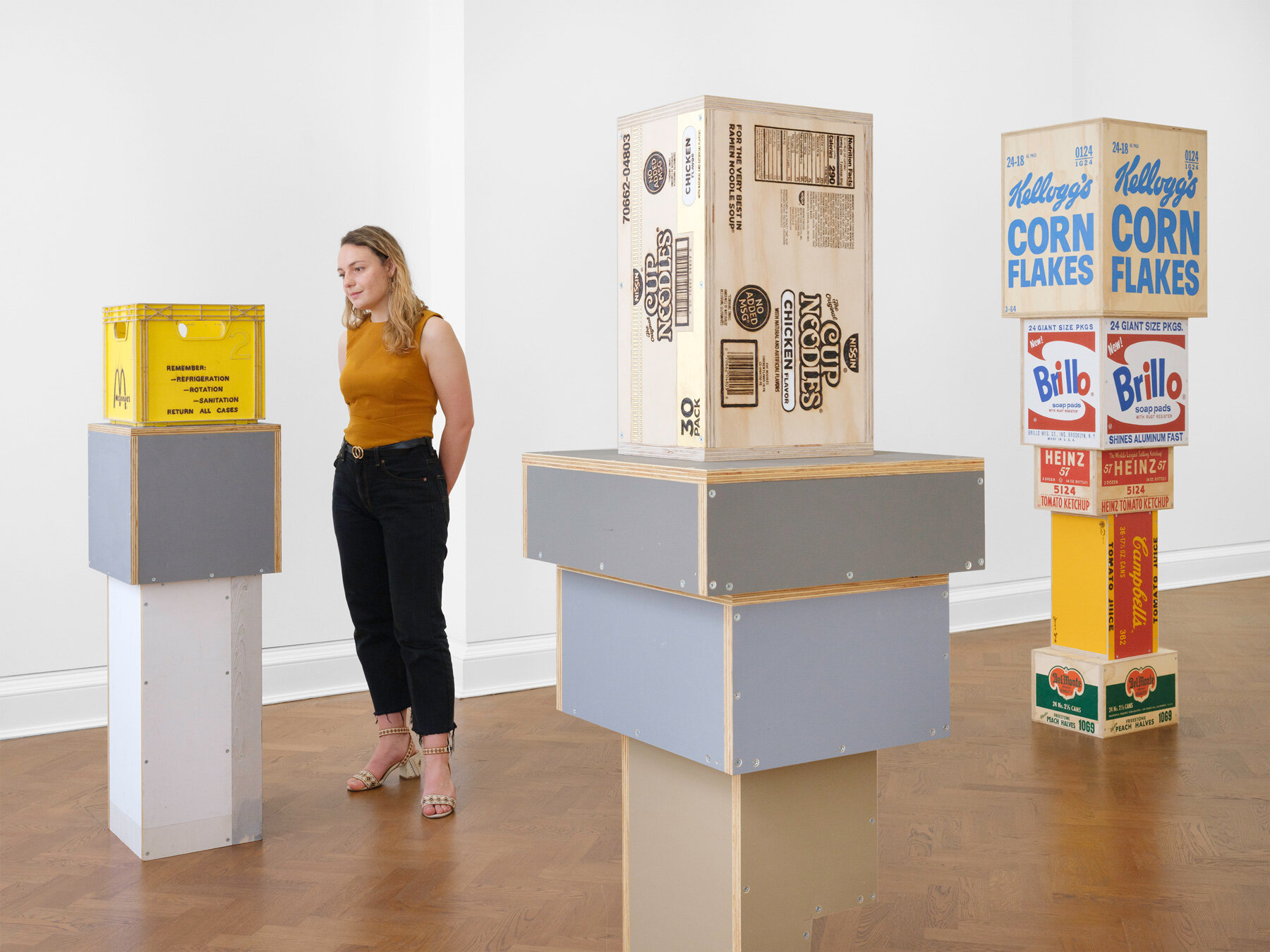
DB: your creative process is very much related to bricolage, a technique that you have been using for many years now. did you start with it or did you get interested in it later on?
TS: I think it was always bricolage. maybe I didn’t have that word, but it was always that technique because I didn’t have formal training. my parents didn’t teach me how to use tools, I had to learn on my own or through friends, kind of casually. I never went to school for it, so I was always figuring it out, and I was lucky enough to be in environments where all that mattered was getting it done. I was talking to a younger artist just yesterday who said, ‘oh, I’m so ashamed, I didn’t want to show you my work because I didn’t think it was good enough and it’s really rough around the edges.’ and I told her, the work is really good, and it is rough around the edges, but do what you’re doing for another, 20 years, 30 years, on top of where you are now you’ll be where I am. it’s not important that the edges be polished, in fact, if you’re just starting, it’d be crazy if the edges are polished. what’s important is that the core is authentic, and slowly it will radiate out and the edges will become polished. but what matters is that the core is an expression of who you are, regardless of how polished that is. that’s key, that’s the secret to any artist and anything, is that it be you. and at 50, almost 55 years old, I’m still working on this concept. I’m not perfect at it, I make mistakes, I go too far, I don’t go far enough. I work with a big team of people and it’s very difficult to keep the team being an amplifier of my ideas, rather than letting me drift into relying on someone’s superior skill. because with 20 people, there’s someone here who’s better at nearly every technique than I am. they’re specialists, like luke’s so much better at ceramics, and chris is so much better a welder, erum is better at negotiating. so, as long as it all feels like me, that’s important. but it does require a constant reminder to make sure that things have my voice.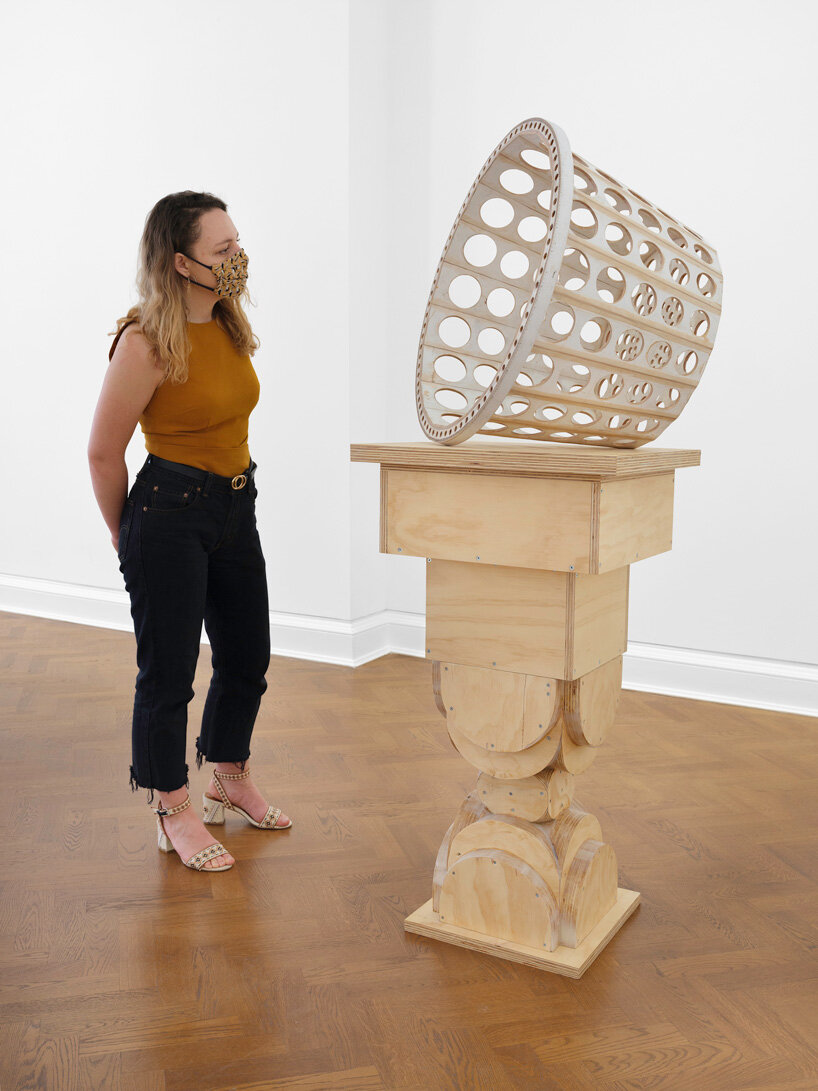
DB: you do very different things, from sculpture to the collaboration with NIKE, and even films. how do you make sure that your voice is present in everything? is there a common thread that ties everything together?
TS: you would laugh, because some of the things that I have to say and do, it’s all these tricks. like, I’m constantly saying to chris, who I’ve worked with, at this point, longer than anyone else is in the studio, ‘can’t you make it worse?’. he’s very precise, and he’s very methodical, and if he makes it, it will never break. he’s very consistent and reliable, and he’s also very slow. actually, he’s not that slow, he’s probably a little faster, but it looks slower. you know, I’ll have to redo something four times. but by doing it four times, you get that accretion of resin, like the inside of the van with all that texture.
I’m a yankee, I come from new england, that’s where I grew up, and there’s a tradition of yankee craftsmen, of american horrible, puritanical, conceptually rigid people that escaped england because of the tyranny to make an even more tyrannical state that we live in now. this unbelievably racist country, and through the internet we’re learning more and more about what’s going on. at the root of it, are these kind of fucked up criminal people that left one place to start a new utopia, but fucked it up and made it even worse. but in the process, they made some of the best-made things ever, american made things, since the industrial revolution and all the way up to now you could argue, if you include apple. so there’s this old expression, a yankee craftsmen expression, ‘there’s never time to do it, right. but there’s always time to do it again,’ as an admonishment to young craftsmen who rush through things. I always take that critique as my motto, just do it fast, do it wrong, and do it again. I’m always teaching that philosophy, successfully, unsuccessfully, whatever, but that’s my struggle.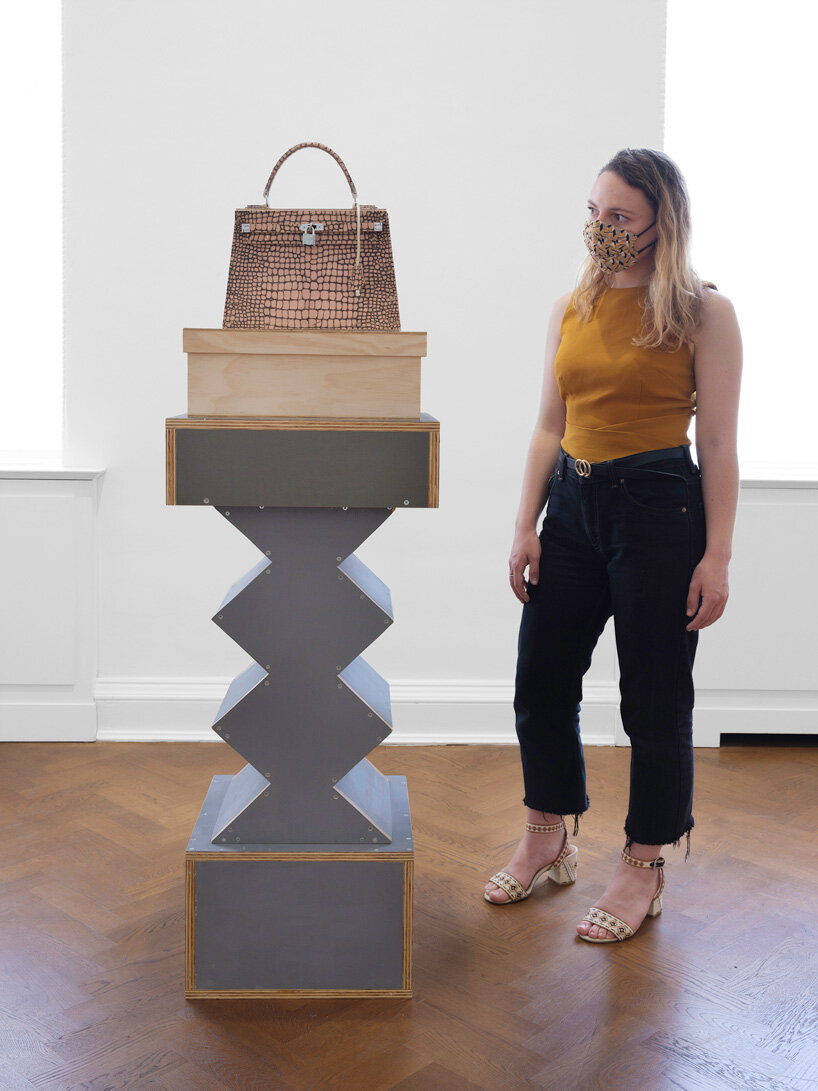
DB: the sculptures on view at thaddaeus ropac combine commonplace industrial objects with modernist-inspired pedestals. how do these two coexist? what is the connection between them?
TS: I’m also a self-taught art historian, I’m interested in the canon, of which I’m part of. it’s almost like the development of science and the understanding of the universe from ptolemy, to galileo, to hawkins to now. I’ve been interested in the evolution of science and our understanding of the natural world around us, but I’m also interested in the development of art, and in particular, the very narrow subject of sculpture. I spent a lot of time studying abstract formalism, like david smith, brancusi, rodin and noguchi. or maybe going from noguchi, who worked for brancusi, who worked for rodin. rodin is the first modern artist in my perspective, because he was the first sculptor to really show fragments and parts of bodies, and repeat parts in different sculptures and make moulds and engage with the modern reproduction process. he was the first artist sculptor in the age of mechanical reproduction, and I don’t think his techniques were revolutionary, but his decisions were. and they were clearly a reflection of our changing times, of repetition, of the beginnings of photography, and you can see it conceptually in his work. then all that led to brancusi’s big move about making the pedestal part of the work, because when you walk into a sculpture exhibition, even today, you’ll see white rectangular blocks with something sitting on top. there’s very little consideration, all that’s doing formally is raising the floor, up to eye level, and it’s making a little floor, or tableau, or table. I still think that’s really stupid, because either exhibit it on the floor and make sure that everyone can get on their hands and knees and look, which they’re never going to do, or, you know, maybe make the floor lower so that you’re at eye level, or what people do is they raise the pedestal to eye level and that’s a function but then you’re looking at a room full of pedestals. brancusi was the guy who said, okay, well, if that’s gonna happen, functionally, let’s make that pedestal complimentary to the form that’s on top. and he did that better than anyone to date. so I use that strategy to make those pedestals, and I’ve made plenty of them to make sure that they compliment the object and that they support it. so when you walk into the room, you see this forest of sculptures and the objects relate to each other, and to the architecture, and then as you get closer, the pedestal goes away. and if you’re this close to where you would be talking to a person, you talk to their face, to their head, you don’t talk to their whole body at one time, and then you can engage with the top, the head, which is the communications part of the sculpture or the person. so it’s my way of trying to continue with that canon, that technology development in art.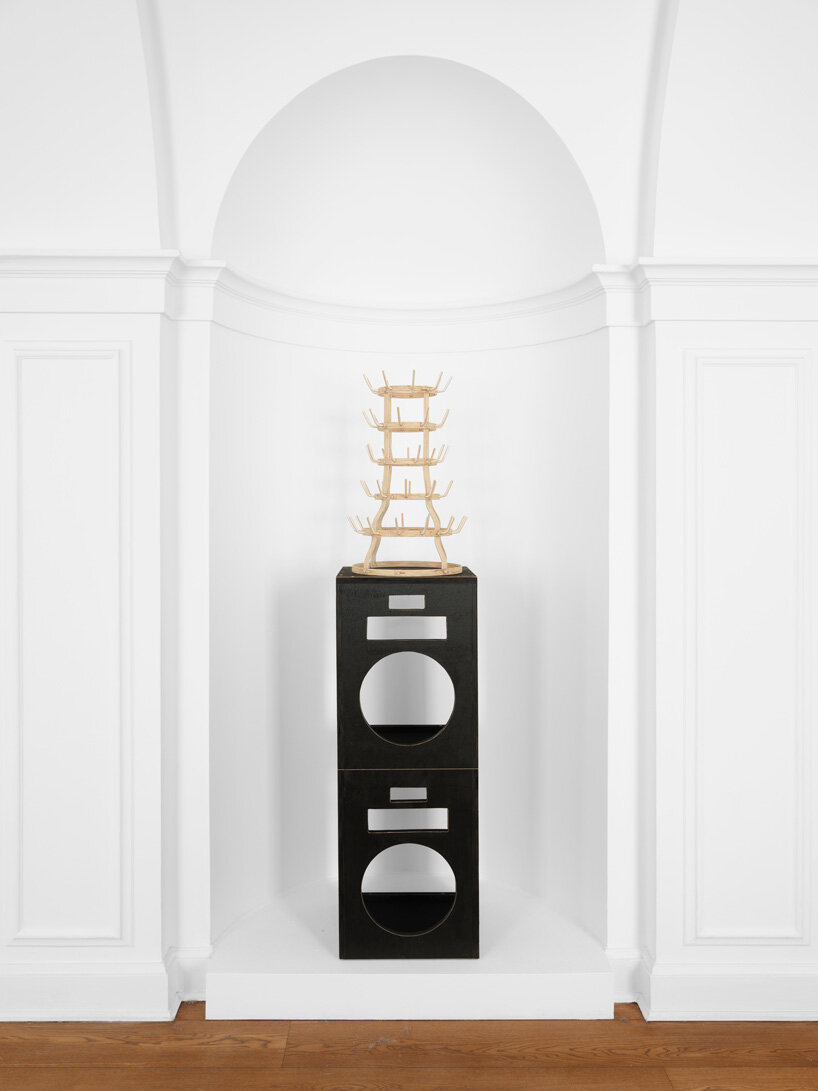
DB: so the pedestal itself becomes a sculpture, right?
TS: totally. and it’s funny because I’ve been working on this for decades, and I once went to someone’s house and saw that they had gotten rid of my pedestal and put the sculpture that I made on a very beautiful prouvé table. but this particular person had good taste and they did it right. I couldn’t afford a $30,000 prouvé table to put my sculpture on, but if I could I might have. so I consider that lucky, even though they kind of disregarded my intention, they did it in the right way. and then so I’m looking also at brancusi books, and I’m looking at ‘bird in space’, his most famous sculpture. by the way, if you want to dig into brancusi, get the philadelphia museum of art catalogue, it’s the book. there are some tiny black and white reference pictures of the arensbergs, who were his biggest american patrons, and they had ‘bird in space’ on a dresser with black and white photos of their families, and other junk. they also disregarded brancusi! so, the king of this whole world became decorate next to some ceramic bowl. it was really humbling to see that, because here’s this guy that I literally put on a pedestal and his gestures were kind of debased or not respected by his greatest supporters.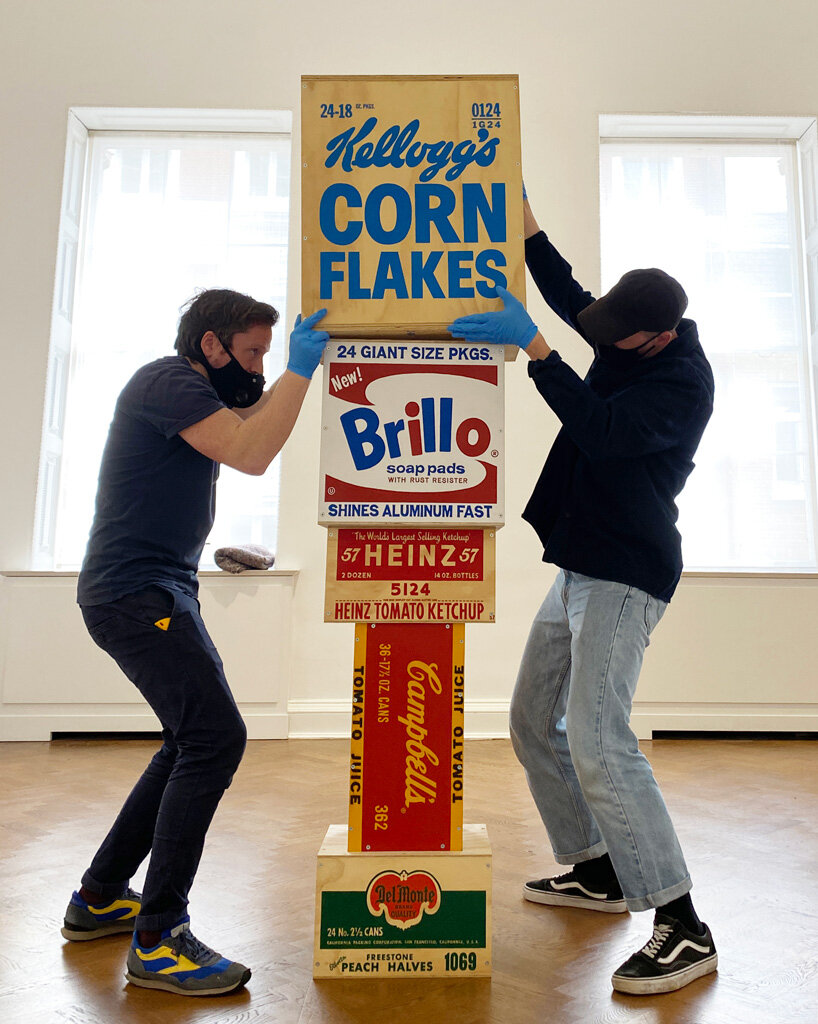
DB: what is the significance of these everyday objects for you, and how do they relate to each other, if they do?
TS: the objects that are represented are carefully selected. I’m not even necessarily making my own version of something else, I am making my own one. so whether it’s a van, like, I can’t have a van like that, because they’re too old and shitty, and I can’t park them. so I made it as big as I could manage. or, there’s a sculpture of a barbie, and I really wanted barbie when I was a child. I wanted her sexually, as a fertility goddess, you know, as a fetish. I think from a pre-sexual age, I was still programmed to be attracted on some level to her plastic breasts or whatever. in a way, me making that barbie is a way to connect with those old feelings. and she also looks a little bit like my wife, so there’s a sympathetic magic and there’s a connection with my real wife, so it’s kind of like a doll about her. it started in my youth, and now it’s about the present, it’s things that go over years. similarly, with ‘figurative tower’, I want an andy warhol art collection, but I couldn’t really deal with it because I’d have to have some other job involving making a lot more money. if I wanted to have five warhol boxes, it would be a tremendous use of my resources that would be not authentic. if I had that money, I’d be using it to save puppies or something useful. but I certainly could manage making these boxes and carefully making my better version. and you would never display or hold boxes in this brancusi-like shape, but this is an opportunity for me to synthesise those two things. they’re not just everyday objects, they’re everyday objects that have I a connection to. the tide bottle, which is the detergent that I use, is also used as grey market currency. it’s the most shoplifted item in my neighbourhood, so when you go into stores, it’s always behind glass because you can pay for drug transactions with tide. it’s also counterfeited, people make fake tide. it has a beautiful color, a pop art shape, it’s got a handle, people like the way it smells, but it’s strange.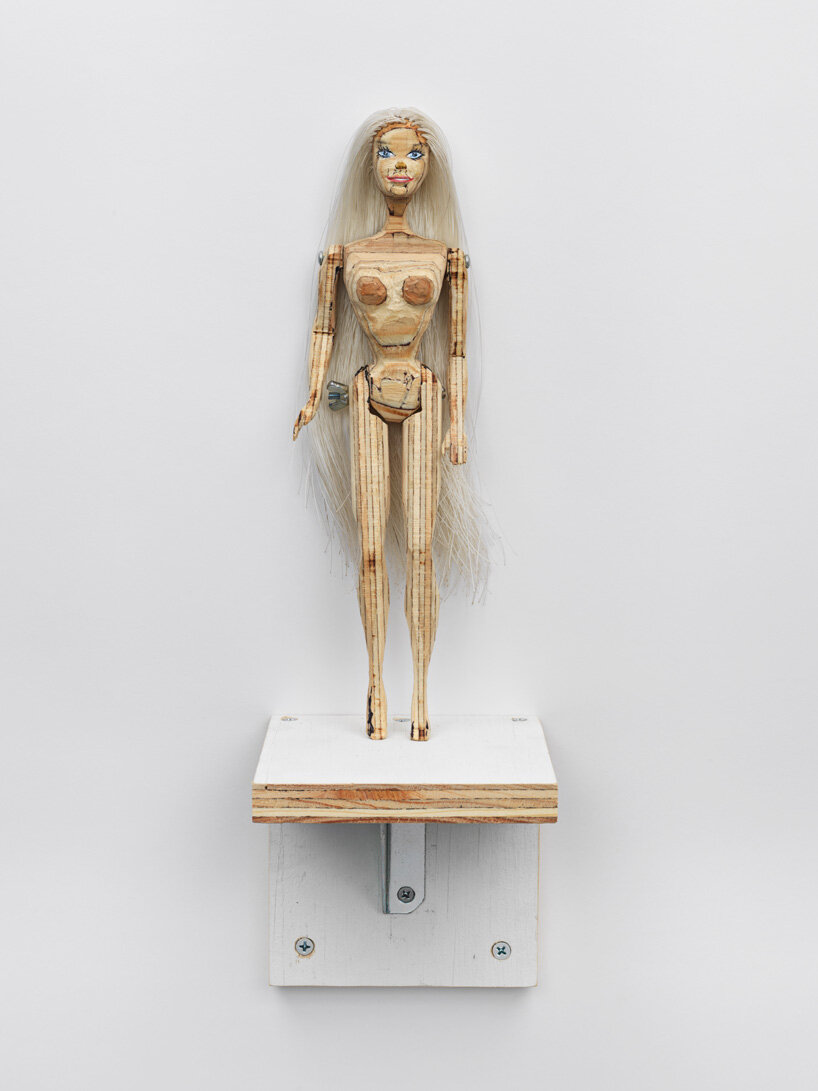 tom sachs, ‘barbie’, 2013 | plywood, vectran, steel hardware | 11.5 h x 3.25 w x 1.625 d inches 2013.340
tom sachs, ‘barbie’, 2013 | plywood, vectran, steel hardware | 11.5 h x 3.25 w x 1.625 d inches 2013.340
DB: so it’s a lot about things that you want, or wanted, and then by making them, you find a way to fulfil that desire, right?
TS: I think that’s called sympathetic magic, and then what winds up happening with sympathetic magic at its highest form, is that you get the girl, you get the iron axe. people who use stone axes graduating to iron axes, getting the magic of a culture’s technology that’s more evolved. and any truly advanced technology is indistinguishable from magic. it is truly magic, because maybe you don’t fully understand how it happened, but you can certainly understand the difference between a stone axe and an iron axe. so a lot of these things that I’m making are forms of my way of engaging with sympathetic magic, of getting the girl, getting the van, finding a way. tide’s a pretty dark subject, because it’s a fucked up thing, but to me, when I look at a title, it’s an andy warhol because of the orange and the blue, it’s a painting. I’ve tried painting it a few times, and it doesn’t turn out right, it had to be a sculpture.
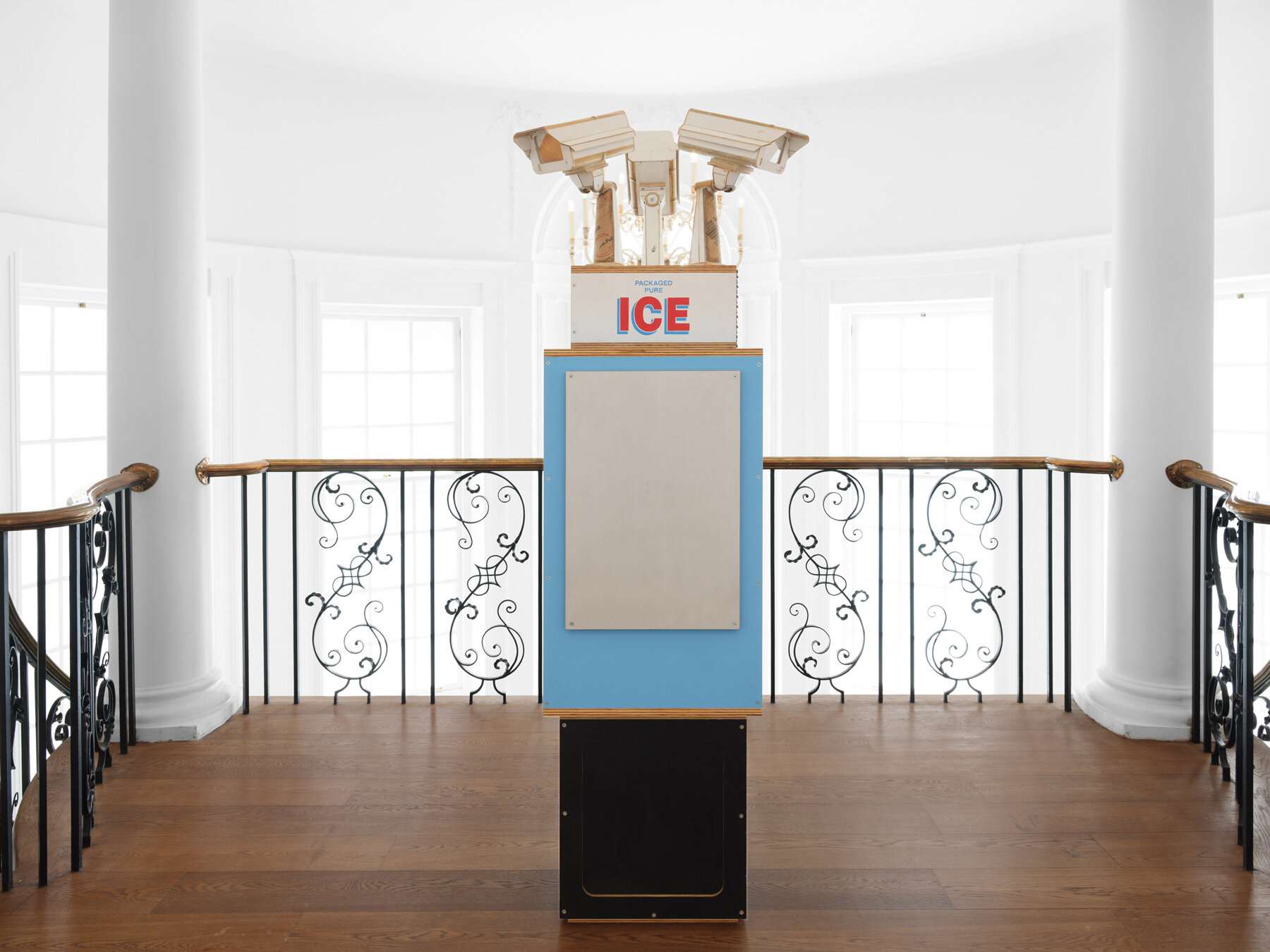
DB: there are also some objects, like for example, ‘ice’, which has these cameras on top. can you tell me more about it?
TS: so those ice boxes are in front of bodegas and delis everywhere, and there’s one that’s just that shape near my house. it’s actually really near the bakery that I go to, so sometimes I’m waiting outside in the hot sun, annoyed, and that’s my buddy who’s always there 24 hours. so I got looking at it and it kept haunting me, like that person that you run into on the street that you can’t get away from, but then it’s part of your community. and then the surveillance cameras on top are a panopticon. they are ever present, watching, and I just wanted to put them together. I mean, bodegas have surveillance, it’s part of it, it has to because they’re 24 hours of dangerous environments. if you run a bodega, you gotta treat it right. I wanted to bring those two things together in a transparent way. I always think it’s interesting, there’s two kinds of surveillance: there’s a hidden camera, and then there’s the panopticon, the camera that says, ‘hey, you’re being watched’. but is someone watching the camera? I don’t know, but it evokes the fear because the thing about the modern police state is not that you’re being watched, it’s that you could be watched. I’m forever interested in this concept, not just from the crime-policing, political state, but from my own sense of observing others and being observed myself. all of those feelings, all those fears and desires are brought to our present in this time, and, to me, those are all the things that the camera represents.
DB: I also get the same idea, whenever there’s a camera, whether it’s working or not – in this case it’s even made of wood – it still evokes that feeling of having to be self conscious and behave in a certain way around it. so it’s very interesting to see it in sculpture, and, if I was there, I would probably still experience it in this way.
TS: even if it’s out of wood! it’s like the natural fear thing. butterflies have dots on their wings, because it was a mutation at first, but then the ones that had dots were less eaten because they looked like predators, and then they reproduced. they triggered that fear. and so, you know, we will evolve to reproduce based on fear of cameras.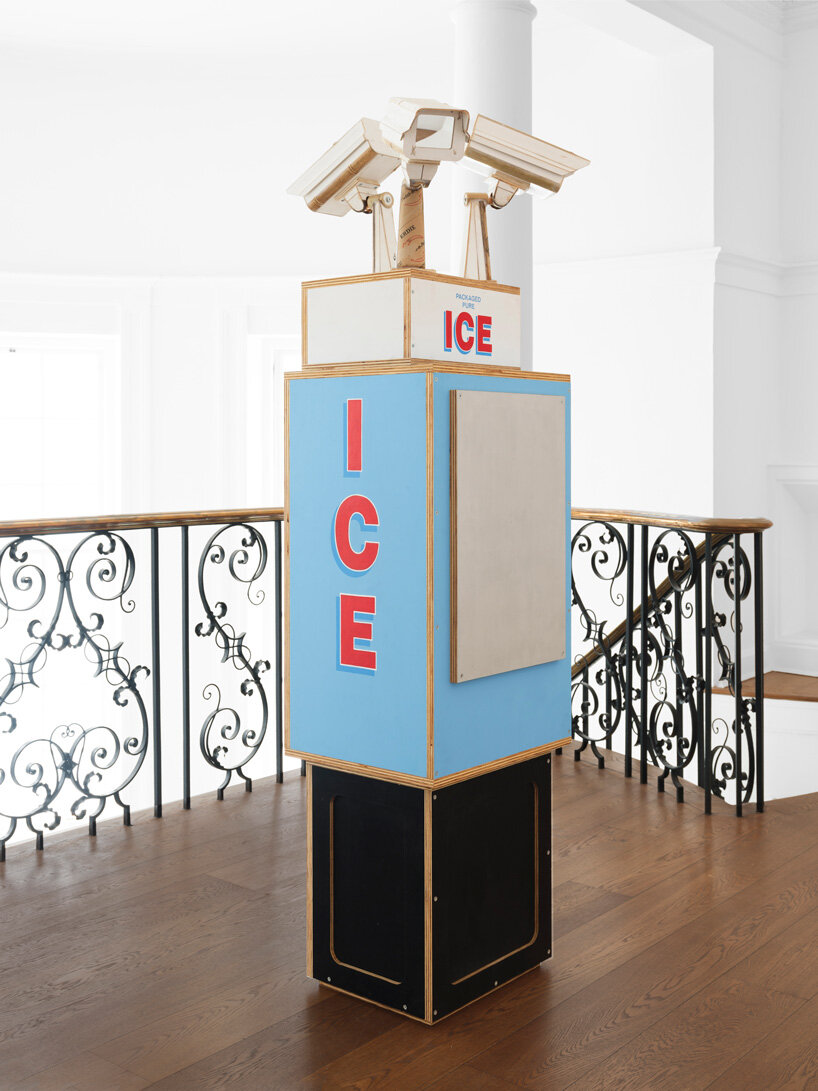
DB: you said you just sent out an exhibition or some works. what are you working on at the moment?
TS: it’s the biggest thing I’ve ever done, and it will be in hamburg in september. it’s the space program number four, at deichtorhallen hamburg. the good news is that it was delayed three times, so we had an extra almost two years to work on it and it’s very polished around the edges.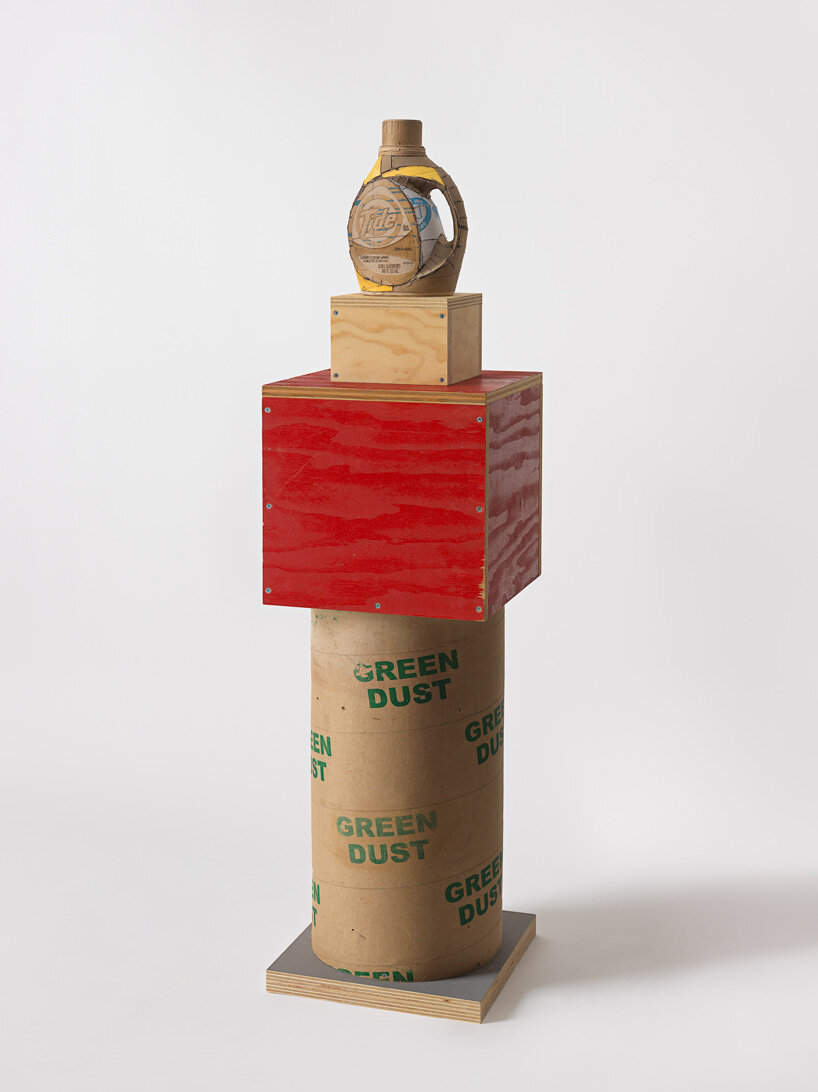 tom sachs, ‘tide’, 2020 – 2021 mixed media including cardboard and epoxy resin | 10 h x 8 w x 4 d inches 2020.369
tom sachs, ‘tide’, 2020 – 2021 mixed media including cardboard and epoxy resin | 10 h x 8 w x 4 d inches 2020.369
THE DESIGN PRIZE is an annual award program that celebrates excellence on a global scale. initiated in 2017 and curated by designboom, with patronage by the city of milan, THE DESIGN PRIZE recognizes both the extraordinary achievements and little sparks of beauty and delight that have emerged over the past 12 months.
art interviews (138)
THE DESIGN PRIZE (67)
THE DESIGN PRIZE 2021-2022 (21)
tom sachs (21)
PRODUCT LIBRARY
a diverse digital database that acts as a valuable guide in gaining insight and information about a product directly from the manufacturer, and serves as a rich reference point in developing a project or scheme.
